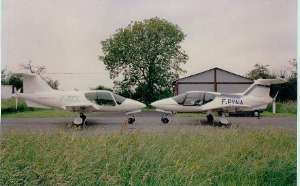|
ORION G-801 AND G-802 PRESENTATION
HISTORY 0F THE AIRCRAFT:
The Orion G-801 was designed in 1975 by Jean Grinvalds of France. It was built privately by himself in the following years. Its purpose was to experiment with a new configuration for a general aviation aircraft which would have improved performances and more comfortable accommodations.
This aircraft benefits from a number of modern technological advantages (pusher propeller, composite material construction) which have been demonstrated experimentally by the prototype. The experience provided by the G-801 has been used in the development of the production model G-802.
DESCRIPTION

The ORION is a four-seater aircraft with the engine located at the center of the fuselage driving a pusher propeller. The airframe is a composite structure basically fiberglass reinforced locally with Kevlar and bonded with polyester or epoxy resins. Sandwich construction uses cores of PVC foam (Klegecell). The retractable landing gear is electrically operated and equipped with a manual back-up. Slotted flaps, electrically actuated, are fitted to the wings.
The engine is a 180 or 200 HP Lycoming I0-360. The three-bladed pusher propeller of 1.55m (3.414 ft.) diameter is of a ground adjustable type, forerunner of a variable pitch model to be made available later.
The transmission of power from engine to propeller is attained by mean of a dry coupling which has been demonstrated in flight over many hours of operation. It is a sort of automatic clutch device (Molt Taylor type) in which special steel pellets replaces the fluid used in automotive types. Its function is to cut out any torsional vibration between engine and propeller. In normal operation, this coupling transmits 100% of power. In addition to this coupling, the transmission includes a sliding sleeve, a tubular carbon drive shaft and an elastically mounted bearing cage in the stern bulkhead which is designed to take over the propeller thrust. Therefore, the propeller thrust is applied directly to the airframe and none of it is felt in the transmission or in the engine. According to Molt Taylor, the presence of the flexidyne reduces the propeller stresses by 8 times in comparison with a conventional tractor installations.
| 

